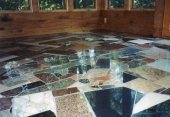Damian Jones wrote:What's wrong with this plan, what's dumb. I'm looking for a good critique.
Thanks,
Damian
Damian, It is great that you are interested in developing your property using a permaculture design! Since you asked for a critique I will give you my take. I don't want to discourage you in any way, but you asked our criticism. perhaps not all of my input will apply to you, but I offer general advice for others that might read this thread at a later date.
Your excitement to get things moving in the spring could lead to some costly mistakes. You likely lack the knowledge required to plan and implement something that you will be happy with in the long run. Observation of the property is key to making a good design. Start slowly this year and gain an understanding of the property in all 4 seasons. Meanwhile you can learn more about rotational grazing, resilient design, soil building, animal husbandry, etc. If you have not already bought books, I would suggest dropping $300 before you commit to more expensive items such as: aquaponics systems, larger animals, trees, equipment. Somewhere on these forums there is a great list of suggested reading material. The information contained within the top 5 permaculture books should provide a great base to start from.
Make a plan. Ask better questions and clearly define your goals for the land. The more specific you can be, the better. It is impossible to implement a good plan without a desired outcome in mind. how many people do you want to feed or what % of your diet do you want to produce? how much income (if any) needs to be generated to cover expenses and taxes? how much working capital are you willing to commit in the first year, and do you expect a return? if you do plan on making it profitable in the first year, what items would you need to produce to make that happen? Would your plans work if you or your family had to leave for some reason such as vacation, illness, or emergency? what is your soil like? have you tested it? do you need to amend it before you plant long term perennial crops like trees and shrubs? Would it be better to dredge and stock your ponds or buy aquaponics systems and heat the water through the winter? which of these (or other) options is most profitable in the first year: crops, hay, leasing the pasture, animal husbandry? are your goals realistic?
My suggestion is to start small. raise a few dozen chickens for a year to see if you like caring for animals. they are easy and cheap. buy a few 20# bags of black oil sunflower seeds (non heat treated variety sold as bird seed) and sow a patch for chicken feed. raise smaller plots of grain for feed and invest most of your energy preparing the garden near the house this spring. plant a few trees and shrubs, but hold off on planting a lot of trees until you can prepare the land correctly and understand your local conditions. get your soil tested! compost shredded leaves and work on building a heavily mulched (6-18") soil in the home garden area. Learn about your land. Observe the stream and see how high it floods during heavy rains. As a part time farmer you won't have the time to tackle a serious workload. Enjoy the fact that you currently have outside employment(where you can do research, plot, and scheme on the clock) and save as much money as you can.









 . I would never suggest such a thing though.
. I would never suggest such a thing though.